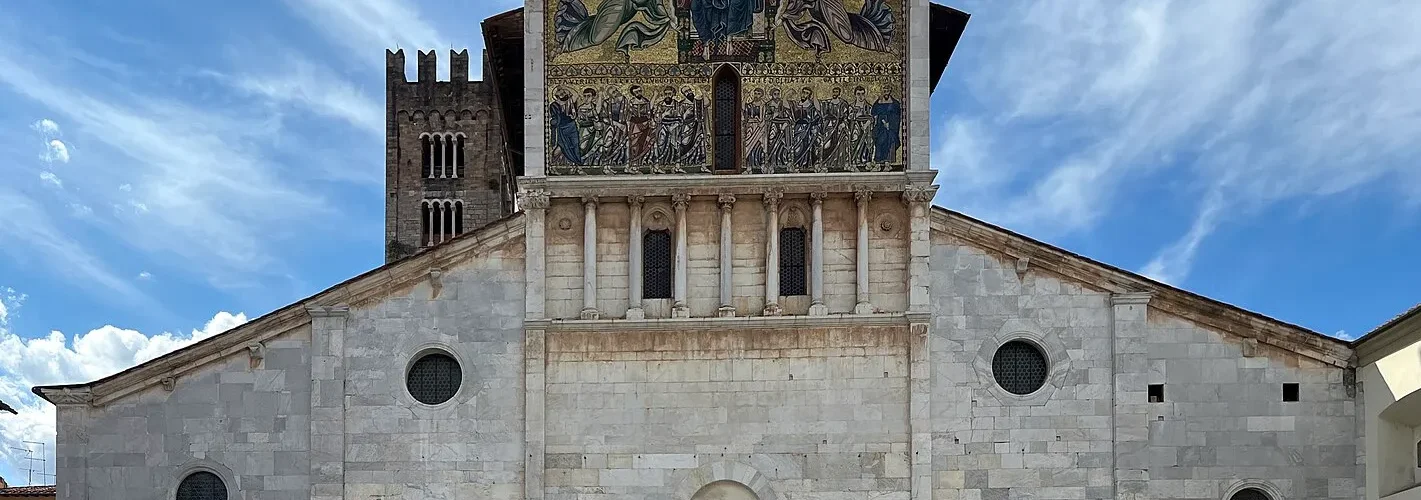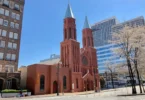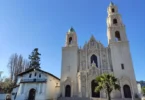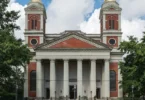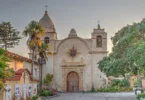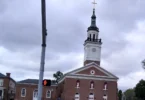Introduction
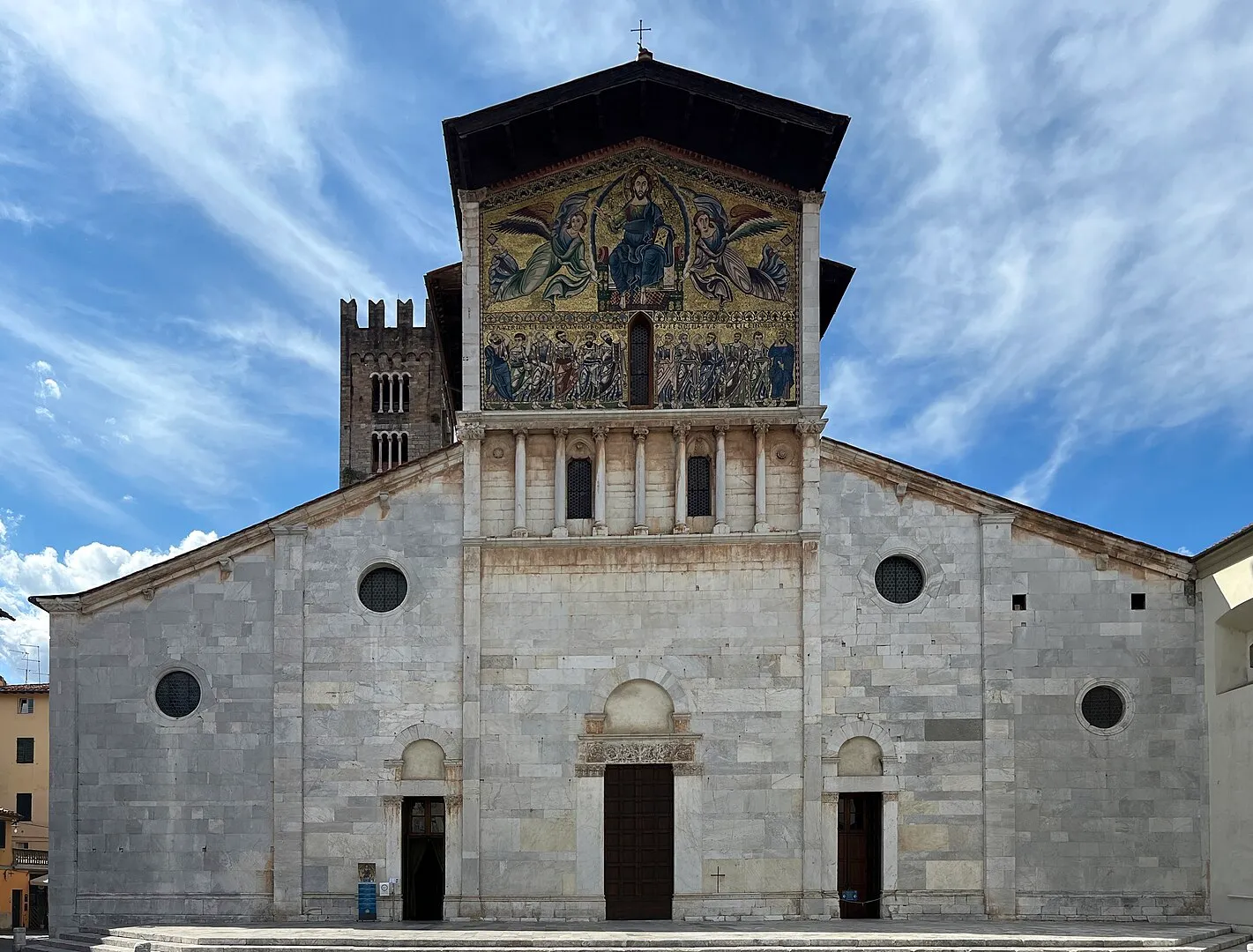
The Basilica of San Frediano is one of the most historic and significant places of Catholic worship in Lucca, Italy. Located in the charming Piazza San Frediano, the church is renowned for its Romanesque architectural style, which showcases the distinctive features of this period, including its robust stone construction and intricate decorative elements. The basilica holds a special place in the religious and cultural life of the city, with deep historical roots that date back to its founding. The church is particularly famous for its stunning mosaic facade, which is a defining feature of its Romanesque design. It also hosts various important religious celebrations, including the annual procession for the Holy Cross that starts from the basilica on the evening of September 13.
In recognition of its historical and spiritual significance, Pope Pius XII elevated the church to the dignity of a minor basilica in November 1957, further cementing its importance within the Catholic Church. Over the centuries, the Basilica of San Frediano has remained a vital center of faith and culture in Lucca, drawing both pilgrims and visitors alike to admire its architectural beauty and deep spiritual heritage.
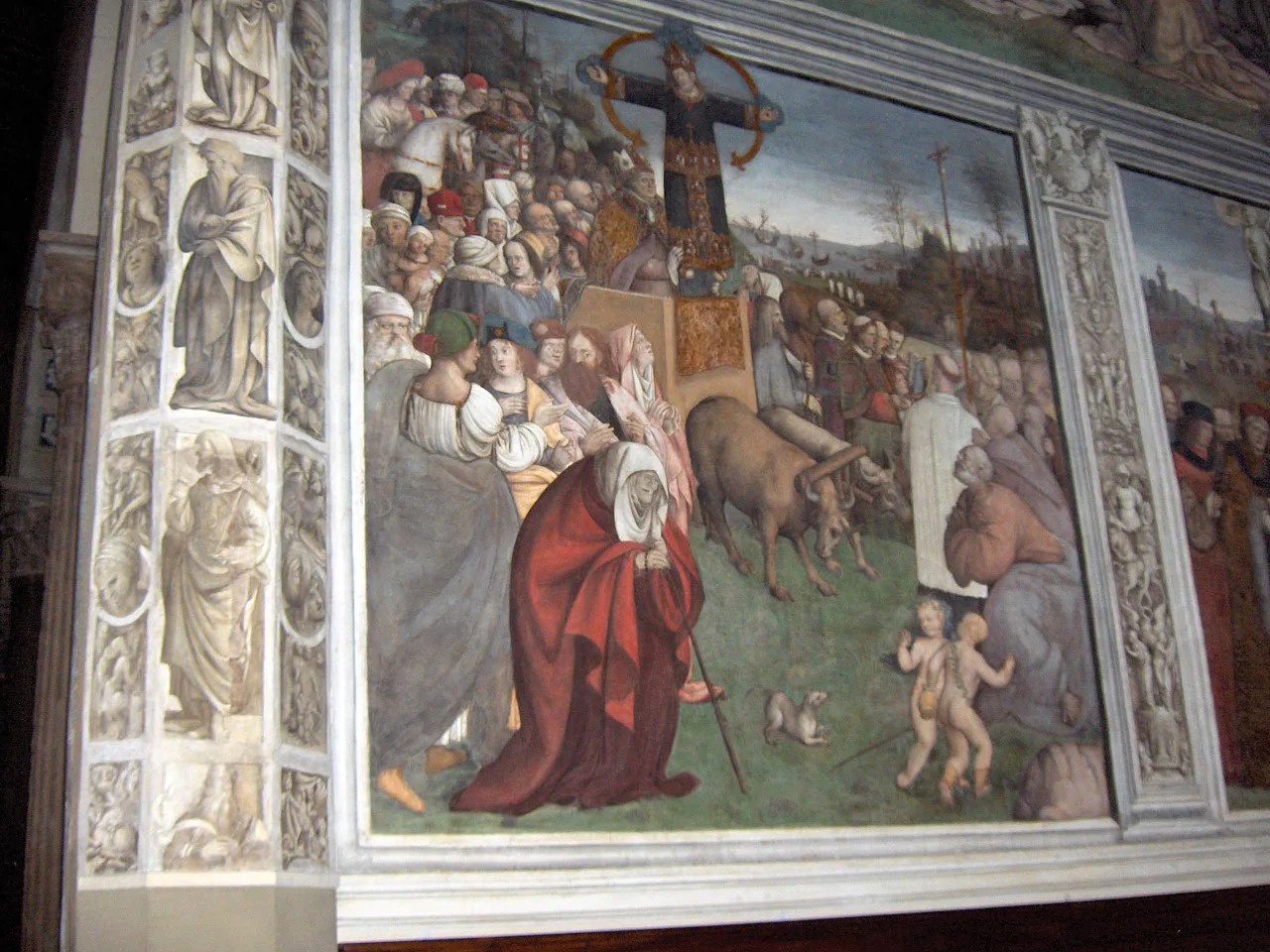
The Basilica of San Frediano in Lucca, Italy, is a church with deep historical and spiritual roots, dating back to the early 6th century. Over the centuries, it has evolved from a small religious site into one of the most significant landmarks in Lucca, both architecturally and spiritually.
Early Beginnings (6th Century)
The origins of the basilica trace back to the 6th century, when a religious building dedicated to the three holy Levites—Saint Vincenzo, Saint Stefano, and Saint Lorenzo—stood on this site. The church was initially founded by San Frediano, an Irish priest who was elected as bishop of Lucca between 560 and 588 AD. Excavations carried out beneath the current basilica have confirmed the existence of this early building, cementing the historical importance of this site in the city’s religious history. During the early years, the church was served by diocesan priests who formed a community of canons. Under Lombard domination, the church and its rectory underwent expansions, reflecting the growing influence of the Christian community in Lucca.
Growth and Development (8th–12th Century)
By the end of the 8th century, a significant addition was made to the church: a crypt was constructed to house the body of San Frediano himself. This crypt became a focal point for pilgrimage, with the church gaining increasing significance as a place of veneration. In 1104, Pope Paschal II confirmed the presence of the canons, formally entrusting them to the clergy of San Giovanni in Laterano in Rome. This acknowledgment by the Pope helped solidify the status of the church in the broader ecclesiastical world.
Reconstruction and Romanesque Influence (1112–1147)
In 1112, the church underwent a major reconstruction under Prior Rotone, who initiated a project to transform the building. The new design followed the growing trend of Romanesque architecture that was emerging in Italy at the time. The reconstruction was completed in 1147, when the church was consecrated by Pope Eugene III. The new church had a three-nave layout, with an apse but no transepts or crypt, reflecting the influence of the Gregorian reform. Interestingly, the church’s façade was oriented to the east, contrary to the typical westward orientation prescribed by the Augustinian rule. This marked a distinct feature of the basilica, aligning it with the broader liturgical trends of the time.
Development in the 13th–14th Century
In the 13th century, the basilica was further altered, with the central nave raised to create more space, and a wooden truss ceiling was added to support the structure. The most striking change during this period was the mosaic decoration of the upper part of the church’s façade, completed between the 13th and 14th centuries. The mosaic, designed by the artist Berlinghiero Berlinghieri, depicts The Ascension of Christ the Savior, with Christ surrounded by the apostles. This mosaic is a prime example of Byzantine and medieval stylistic influences, and it remains one of the most important and recognizable features of the basilica.
Expansion and Artistic Flourishing (14th–16th Century)
During the 14th to 16th centuries, the basilica saw the addition of numerous chapels along the side naves. These chapels were primarily built for the nobility of Lucca, who wished to have private spaces for devotion and burial. As a result, the basilica’s interior grew even more ornate, with lavish decorations, including paintings and other forms of art, that reflected the wealth and religious devotion of Lucca’s elite. The continuous expansion and decoration of the church during these centuries further enhanced its grandeur and made it a center of both religious and artistic activity. The Basilica of San Frediano thus became not only a place of worship but also a key symbol of the city’s cultural and spiritual heritage.
Modern Recognition
In 1957, in recognition of its historical, architectural, and spiritual significance, Pope Pius XII elevated the Basilica of San Frediano to the status of a minor basilica. This designation highlighted the importance of the church within the broader context of Catholicism and marked a significant moment in the church’s long history. Today, the Basilica of San Frediano remains a vital part of Lucca’s religious life, attracting visitors from all over the world who come to admire its beautiful Romanesque architecture, remarkable mosaics, and rich history.
Architecture of Basilica of San Frediano, Lucca, Italy
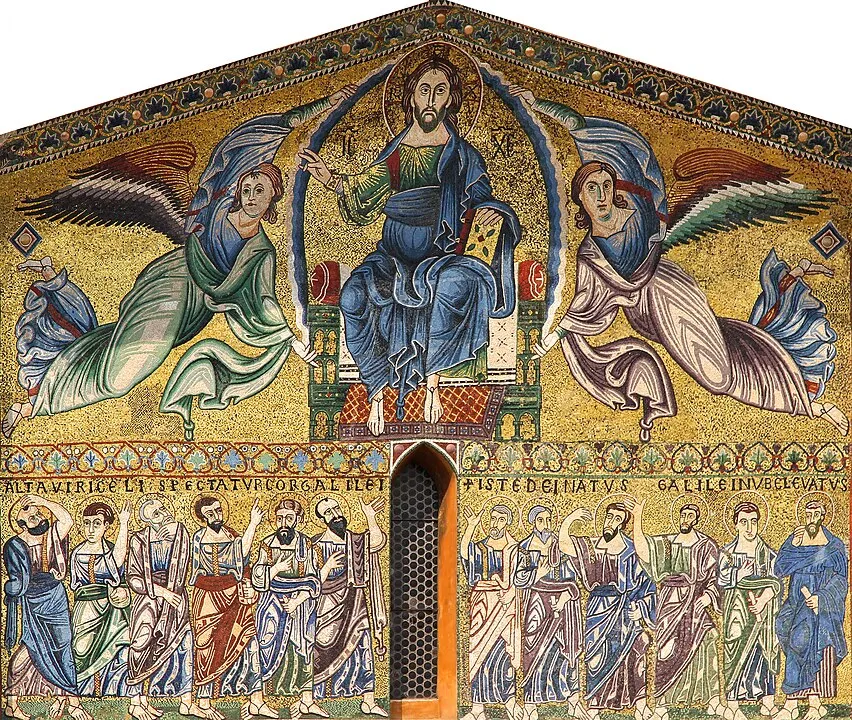
Architectural Style: Renaissance Architecture
Burials: Richard the Pilgrim
The Basilica of San Frediano is a striking example of Romanesque architecture in Lucca, Italy. It is renowned not only for its historical significance but also for its rich and diverse collection of artworks and architectural features, which blend medieval and Roman influences. The church’s design and structure provide a window into the architectural evolution of the region from the 6th century through the 16th century.
Facade
The facade of the Basilica of San Frediano, dating to the 12th century, is a prominent feature of the church and a fine example of Romanesque style. Constructed from polished stone, it is vertically divided into five distinct sections. These sections correspond to the central nave, the two lateral naves, and the two bands of lateral chapels. The three main portals are framed by pillars and surmounted by a simple architrave, with the central one decorated with plant motifs. Above the portals, there are blind arches that add to the facade’s ornamental detail.
At the central level, a small loggia with semi-columns is present, surmounted by capitals of various designs. This loggia encloses two single-lancet windows, allowing natural light to filter into the interior. Above the loggia is the magnificent 13th-14th century mosaic, depicting the Ascension of Christ, surrounded by angels and apostles. Originally, the mosaic was framed by the image of the Madonna, but this was later obscured by the central single-lancet window. The upper portion of the mosaic reflects the influence of Byzantine art, while the lower area appears to be the work of a local artist, likely from the Berlinghieri painter’s workshop. Roman iconographic elements, such as the depiction of Christ in a mandorla (an almond-shaped halo), as well as Peter and Paul being portrayed in relief, can be recognized. The mosaic stands as a testament to the blending of Byzantine and local artistic traditions during the period. In addition to the three main windows, the facade also features four oculi placed more laterally, enhancing the building’s symmetry and allowing additional light into the church.
Bell Tower
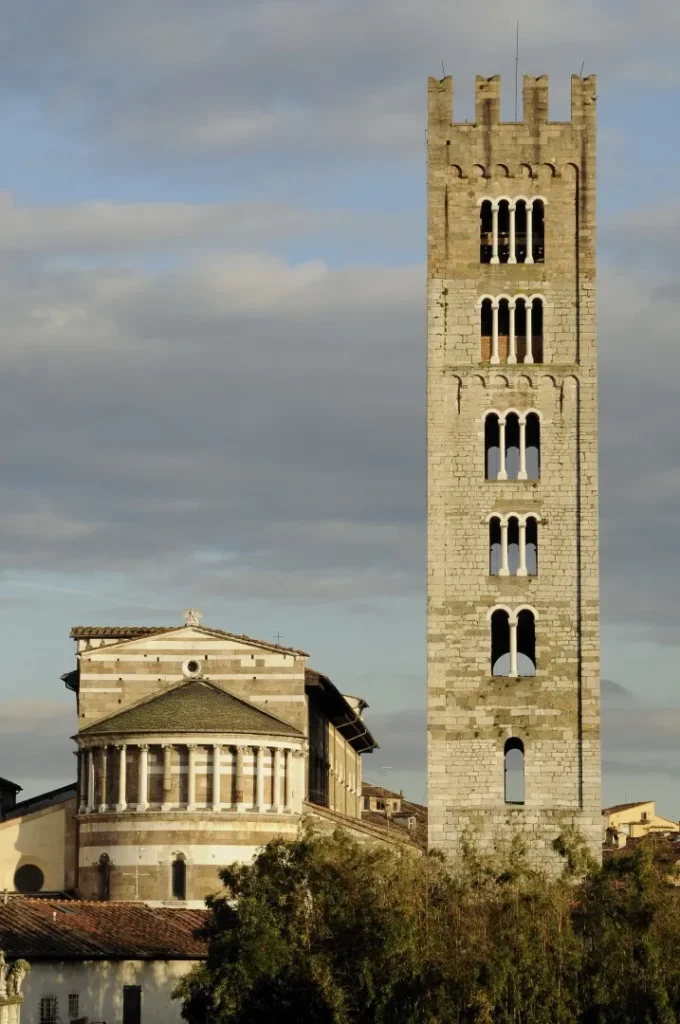
The bell tower, located near the apse, is a key architectural feature of the Basilica of San Frediano. The tower was constructed in multiple phases, with the dark stone base predating the 12th century, while the upper portion in lighter stone was rebuilt in the 13th century. The tower is adorned with a variety of windows: single-lancet windows, double-lancet windows, and triple-lancet windows, arranged in two registers, with the topmost levels featuring four-lancet windows. Each of the windows is surmounted by blind arches, contributing to the tower’s Romanesque aesthetic. At the top of the bell tower, a Ghibelline battlement crowns the structure, offering a medieval touch. The tower houses six bells, each cast by different foundries over the centuries, contributing to the rich soundscape of the basilica. Notably, the bells include two cast in 1804 by the Lorenzo Lera Foundry and others dating back to 1679 and 1401, reflecting the church’s deep historical roots.
Interior Architecture
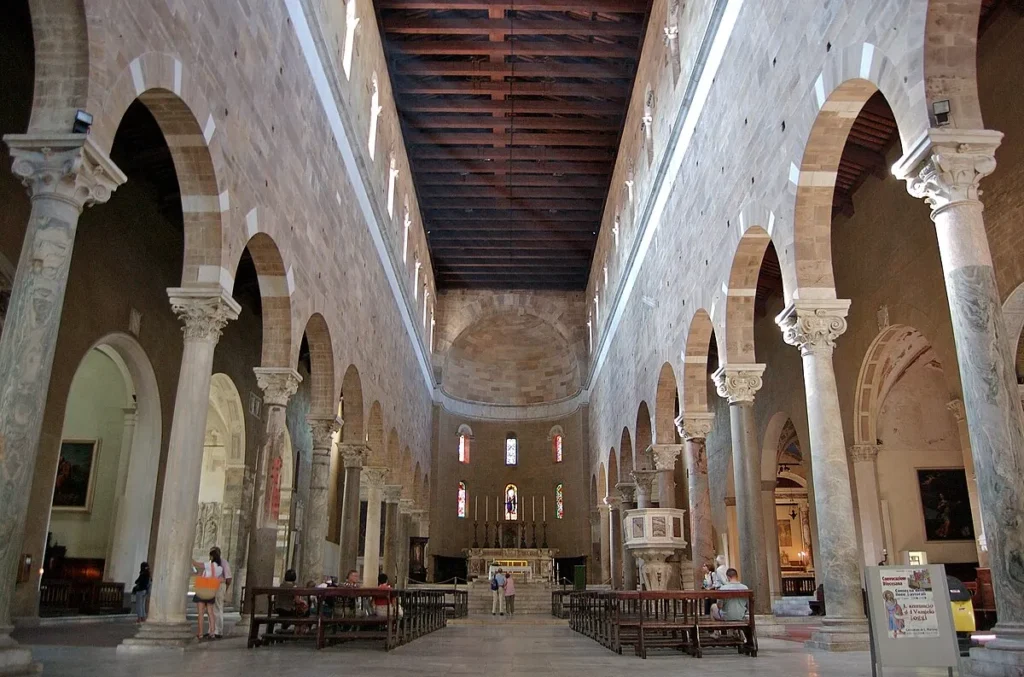
The interior of the basilica is defined by its three-nave layout, a characteristic feature of early Christian and Romanesque basilicas. The columns supporting the arches are mostly spolia (recycled materials) taken from ancient Roman structures, particularly the nearby Roman amphitheater. The capitals of these columns also have Roman origins, enhancing the continuity between ancient and medieval architectural styles.The central nave of the basilica is particularly striking, thanks to a significant raising of the nave in the 13th century, which allowed for a higher ceiling, crowned by a wooden truss ceiling from the same period. This ceiling design is a beautiful example of medieval craftsmanship and adds to the church’s imposing interior. The central nave culminates in an apse, while the lateral naves end in flat walls, further emphasizing the church’s Romanesque simplicity. The transept, a common feature in many basilicas, is notably absent here.
In the 14th to 16th centuries, several chapels were added along the side naves, creating an illusion of a five-nave structure. These chapels not only provided space for private devotion but also became places for the nobility of Lucca to be buried, contributing to the expansion of the basilica’s artistic and architectural heritage. The Romanesque style of the church is evident throughout, particularly in the smooth curtain walls, simple architectural elements, and the classical Roman traditions reflected in the colonnades, arches, and capitals. These features are mirrored in other nearby churches, such as Sant’Alessandro, which also retains its early Christian roots.
Works of Art in the Naves
The interior is home to numerous artistic treasures, many of which reflect the basilica’s long history. Notable works include the baptismal font (or Fonte Lustrale), one of the finest examples of Romanesque sculpture in Lucca. This 12th-century font was crafted by Master Roberto, with contributions from two other anonymous artists. The basin is decorated with scenes from The Story of Moses, while the tempietto (canopy) above features representations of the Apostles and the Months of the Year. The font remains a significant symbol of the basilica’s sacred function and historical artistry.
On the right wall of the central nave is a fresco depicting the Martyrdom of Saints Lorenzo, Vincenzo, and Stefano, dating back to the early 12th century. This fresco is one of the oldest examples of medieval painting in Lucca. Two additional frescoes of Saint Helena and Saint Stephen, created in the 14th century, can also be seen on nearby columns.
In the right aisle, two glazed terracotta lunettes from the early 16th century depict the Annunciation and Saint Bartholomew, attributed to the Robbian school. These vibrant works are prime examples of the influence of the della Robbia family on the region’s artistic heritage. At the main altar, a 16th-century tomb holds the relics of San Frediano, while the surrounding Cosmatesque floor remains from the 12th century, adding a timeless touch to the altar area. The altar is flanked by a number of important works, including a canvas by Pietro Sorri depicting the Martyrdom of Saint Fausta.
Chapels
A large space on the right near the entrance portals of the church leads to two significant chapels: the Chapel of Soccorso and the Chapel of Santa Zita. The Chapel of Soccorso, dating back to the 16th century, was commissioned by Eufrosina Compagni in 1509, who hired Giuliano da Pisa to fresco the altar with the Madonna del Soccorso in 1510. The chapel also features the Madonna del Riposo on the right wall, a piece dating back to the 13th–14th centuries, along with Romanesque columns and capitals on the opposite wall, which complement the Guidiccioni tombs of the 13th century. The Chapel of Santa Zita, built over the burial site of Saint Zita, was originally owned by the Fatinelli family and renovated in the 17th century. It contains significant artworks, including Paolo Guidotti’s Saint Zita and the Poor Man (1611–1612) and five canvases by Francesco del Tintore depicting the Miracles of Saint Zita. Beneath these paintings lies the incorrupt body of Saint Zita, which remains a focal point for veneration.
At the end of the right nave stands the Guinigi-Micheli Chapel or Chapel of the Holy Sacrament, housing a 13th-century fresco depicting the Crucifixion and a painted altarpiece by Masseo Civitali, nephew of Matteo Civitali, with the Assumption of the Virgin. The Buonvisi Chapel, built in the 16th century and later renovated with 18th- and 19th-century decorations, contains works by Stefano Tofanelli and other artists. Further down the aisle, the Chapel of Sant’Agostino, decorated by Amico Aspertini in the early 1500s, showcases scenes from the life of Saint Augustine and local ecclesiastical history. The Trenta Chapel, built in the early 15th century, features a polyptych by Jacopo della Quercia with the Madonna and Child and tombs for Lorenzo Trenta and his wife. It also houses the sarcophagus of Saint Richard the Pilgrim, an English nobleman who died in Lucca during a pilgrimage to Rome.
The Sandei Chapel, constructed in the 14th century, features frescoes, a 17th-century canvas of the Annunciation by Gaspare Mannucci, and a reliquary containing the bones of Saint Cesario of Terracina. In the Chapel of the Cross, frescoes by Amico Aspertini depict divine scenes and trompe l’oeil elements, creating a striking visual experience. Finally, the Chapel of St. Anne, constructed in the 16th century, holds 19th-century works, including The Death of St. Anne by B. Rocchi and The Birth of Mary by A. Cecchi, adding to the chapel’s spiritual and artistic richness. These chapels, with their historic relics, religious artworks, and sacred spaces, offer visitors a profound glimpse into the cultural and devotional history of Lucca.
Feast Day
Feast Day : 18th March
The feast day of San Frediano (Saint Frediano) is celebrated on March 18th. He is the patron saint of Lucca, and his feast day honors his life and contributions to the city. San Frediano was a 6th-century Irish missionary who became the Bishop of Lucca. The Basilica of San Frediano in Lucca is dedicated to him and is an important site for veneration.
Church Mass Timing
Monday : 9:00 AM
Tuesday : 9:00 AM
Wednesday : 9:00 AM
Thursday : 9:00 AM
Friday : 9:00 AM
Saturday : 9:00 AM
Sunday : 5:30 PM
Church Opening Time:
Monday : 9:30 am – 4:30 pm.
Tuesday : 9:30 am – 4:30 pm.
Wednesday : 9:30 am – 4:30 pm.
Thursday : 9:30 am – 4:30 pm.
Friday : 9:30 am – 4:30 pm.
Saturday : 9:30 am – 5:00 pm.
Sunday : 9:30 am – 4:30 pm.
Contact Info
Address :
Piazza S. Frediano, 55100 Lucca LU, Italy.
Phone : +393498440290
Accommodations
Connectivities
Airway
Basilica of San Frediano, Lucca, Italy, to Capannori Airport, distance between 18 min (8.8 km) via Via Romana.
Railway
Basilica of San Frediano, Lucca, Italy, to Lucca Viale Camillo Benso Cavour, Lucca, Province of Lucca, Italy, distance between 6 min (1.3 km) via Via Cesare Battisti.

